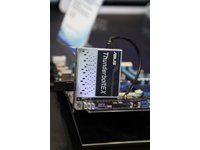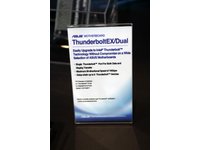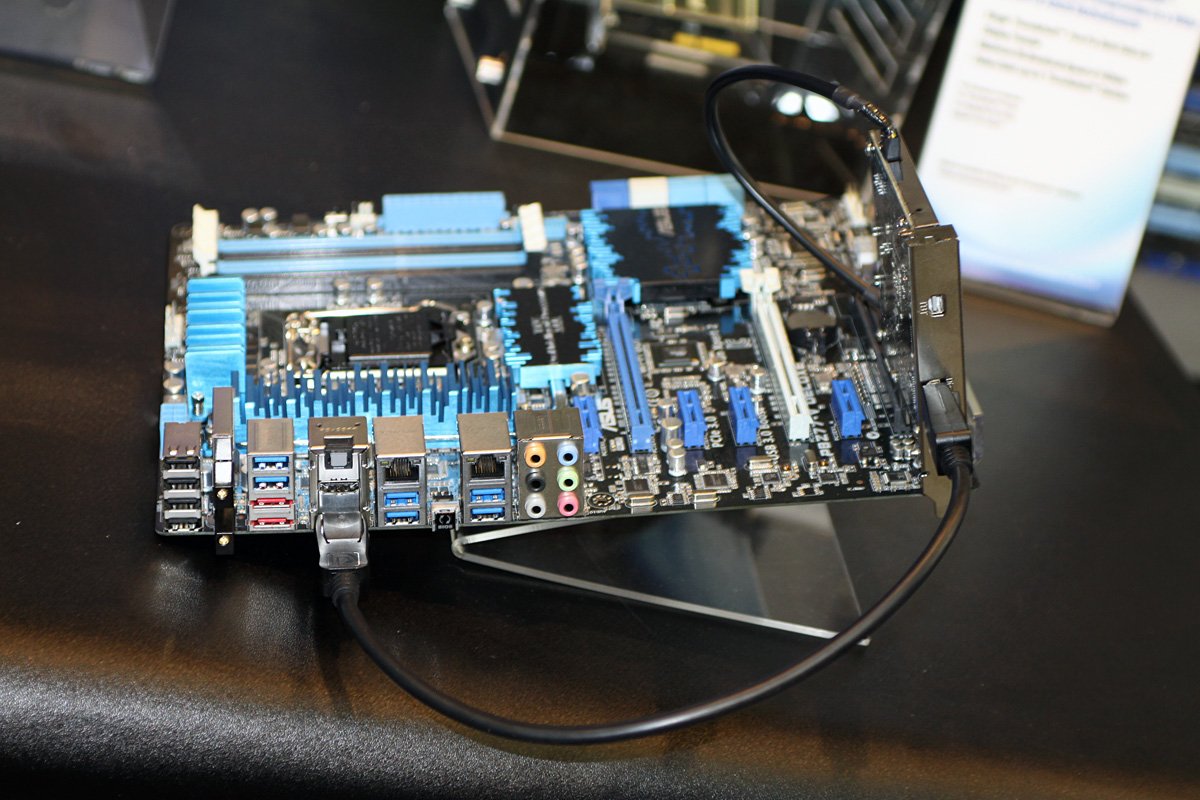Asus Unveils Thunderbolt Add-In Upgrade Card
Asus is demonstrating the first add-in card to extend its motherboards with Thunderbolt support.
Asus is demonstrating at Computex 2012 the first add-in card to extend its motherboards with Thunderbolt support. Available in July for about $200, the ThunderboltEX PCIe card is connected to a graphics card or onboard graphics via DisplayPort. The loop-through enables users to combine Thunderbolt with a powerful graphics card. According to Asus, the Thunderbolt card also functions without the DP port connection; however, in this case, it will only be able to support regular data transfers to other Thunderbolt devices, but will not support a Thunderbolt display.



Depending on model, either the Thunderbolt EX and Thunderbolt EX/Dual, the add-in cards feature one or two Thunderbolt ports, one or two DisplayPort in connectors (so you can input a video signal and output to a Thunderbolt monitor), 10 Gb/s max bandwidth total, and up to 6 devices in a daisy-chain.
Only ten Asus motherboards currently support the add-in card. A requirement for the card is a TB_Header port which is only available on Ivy Bridge boards with H77 and Z77 chipsets. The supported boards are the P8Z77-V Deluxe, P8Z77-V, P8Z77-V LE, P8H77-V, Sabertooth Z77, P8Z77-V Pro, P8Z77-V LE Plus, P8-Z77-V LK, P8H77-M Pro and Maximus V Gene.
Get Tom's Hardware's best news and in-depth reviews, straight to your inbox.

Douglas Perry was a freelance writer for Tom's Hardware covering semiconductors, storage technology, quantum computing, and processor power delivery. He has authored several books and is currently an editor for The Oregonian/OregonLive.
-
ubercake Can anyone please give me a practical current day application of Thunderbolt technology that does not involve simply connecting a monitor to your PC with by way of this new-fangled connection? Hardly any mainstream monitors have a display port connection but we see them on video cards and now we're talking about hooking monitors up via thunderbolt. Well, if my video card only processes so quickly the slot it is in has so many lanes and the bus it's on only supports a certain bandwidth, how does a cable from my PC to my monitor make anything faster?Reply
Seems like it would be a good USB replacement allowing disks to not even have to be housed within the case any longer? Will there be external video cards or something that will be faster than internal cards using this connection? Will they be faster than the next iteration of PCIe (4.0?)? Will Thunderbolt replace current internal busses? Why do I need a loop through to use a powerful graphics card?
If a Thunderbolt card runs on a PCIe slot, doesn't that mean PCIe speeds are still faster?
I guess I'm still trying to grasp the importance of Thunderbolt other than the latest in marketing some product that's been out a while that hardly anyone's wanted to use?
I hate to sound like an idiot, but can someone please help me out here? -
bucknutty I guess we have to keep moving forward.Reply
Perhaps in a few years TB will be mainstream and we will have universal TB docking ports with external video cards, and extra storage, for laptops. Thats the only consumer use I can see for this in the near future. -
kronos_cornelius @ubercakeReply
Totally agree. I will let the early adopters be the guinea pigs, but current PCIe and Display port meet or exceed current hardware. A quick read of the Thunderbolt standard even mentions there is no need for fiber optics at this point, which is the only cool thing I find about the technology.
Maybe once the standard goes into say 40Gb/s and Intel uses fiber to communicate chips withing the mobo, maybe the the technology will catch up with the hype. For now, I think is better to spend the money in something where you can measure the improvement. -
Belardo $200 is far to expensive... but even a Z77 board with TB costs about $200 extra. ($450 - ASUS).Reply
If a Thunderbolt card runs on a PCIe slot, doesn't that mean PCIe speeds are still faster?
PCIe is an internal expansion slot. The slots are not serial - cannot be daisy chained TB is external.
It means that a notebook can have a TB port and you can buy a TB video card (GeForece 890) that plugs into a TB case (with a PCIe port) or a TB native video card and get FULL desktop power.
Of course, that doesn't matter so much in a world in which games are only for consoles. -
CaedenV ubercakeCan anyone please give me a practical current day application of Thunderbolt technology that does not involve simply connecting a monitor to your PC with by way of this new-fangled connection?At the moment there is only 1 other application which is external HDDs for high throughput demands (think video editing off of a portable HDD or raid box). In theory we will later get functionality for high end cameras and other such devices that require mass throughput, but as of yet it is just for ultra high resolution displays and HDDs... and being able to daisy chain both devices (for example you can run multiple HD displays via a single cable from your computer) :)Reply
Either way it is super expensive. until it comes integrated on the mobo like it was supposed to be, or else a $50-75 add-on card this is just an insane amount of money for a display adapter. -
goodguy713 the only real benefit i see with this thunderbolt upgrade ... well like 2 things .. it should enable 4k resolutions.. and the other is if you have a labtop computer .. with thunderbolt you could buy an adapter and use it to add a gpu to your laptop .. there are gpu addons of this sort that have been made .. weather or not it would be beneficial is another story.. i havent really looked into any benchmarks for it .. but that is what some are doing ..Reply -
warezme TB is another technology that can't fit an industry that is far behind. In an ideal market we would all be pushing 4K displays on high end vid cards. Unfortunately the real world is stuck on console spec's and 1920x1080 TN low quality LCD screens. The promise of high res high quality panels has been promised year after year yet no one makes anything the consumer can buy. The industry is blindly stumbling over first low quality netbooks and now low quality pads and then low quality ultrabook, the rest of the world be damned.Reply

